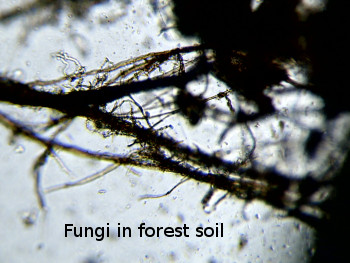
Plants farm bacteria and fungi
 Just
as the sun forms the focus of the above-ground food web, plant
roots form the nucleus of the below-ground food web. Every plant
exudes sugars, carbohydrates, and proteins from their roots, sometimes
giving away as much as 40% of the high energy foods they worked so hard
to produce. Why?
Just
as the sun forms the focus of the above-ground food web, plant
roots form the nucleus of the below-ground food web. Every plant
exudes sugars, carbohydrates, and proteins from their roots, sometimes
giving away as much as 40% of the high energy foods they worked so hard
to produce. Why?
Plants are, in essence, farming bacteria and fungi. These
microorganisms cluster around roots and soak up the high quality plant
exudates, then provide services to the plant in return.
Mycorrhizal fungi bind to the plant roots and carry nutrients and water
from long distances away to feed their plant buddies. Fungi also
store easily leachable calcium in crystals on their backs, where the
nutrient can cycle through the food web and return to plant roots
rather than being lost.
Bacteria do their part in the root zone too, cycling nutrients out of
forms inaccessible to plants and into forms roots can easily suck
up.
In addition, good bacteria (and fungi too) protect the plant from
pathogens. They both bind tiny soil particles into larger
particles, thus improving the soil structure, drainage, and aeration.
| This post is part of our Living Soil lunchtime series.
Read all of the entries: |
Want more in-depth information? Browse through our books.
Or explore more posts by date or by subject.
About us: Anna Hess and Mark Hamilton spent over a decade living self-sufficiently in the mountains of Virginia before moving north to start over from scratch in the foothills of Ohio. They've experimented with permaculture, no-till gardening, trailersteading, home-based microbusinesses and much more, writing about their adventures in both blogs and books.
Want to be notified when new comments are posted on this page? Click on the RSS button after you add a comment to subscribe to the comment feed, or simply check the box beside "email replies to me" while writing your comment.
